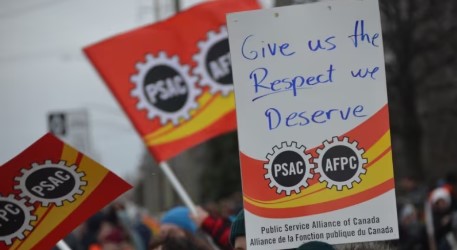
Picketers march around the Office of the Prime Minister and Privy Council as public sector union workers with the Public Service Alliance of Canada (PSAC) continue to strike, in Ottawa, Ontario, Canada April 24, 2023. REUTERS/Blair Gable
Kara Brulotte • Posted: 17-05-2023
The recent twelve-day public worker strike brought striking back to Canada’s public eye, with the last nation wide strike happening in 2004, nearly 20 years ago. Strikes have been used throughout history to push for workers rights, but what exactly are they, and what are the circumstances surrounding this most recent one? A strike is defined as a refusal to work organized by a body of employees as a form of protest, and they can last anywhere from a couple of hours to multiple months. Workers can strike for many different reasons, including to raise wages, improve benefits, get types of leave, and more recently, to remain working virtually instead of in person.
In Canada, legal strikes are organized by unions, which many employees, both public and private, are a part of, with the striking union being the Public Service Alliance of Canada (PSAC). This union represents 155,000 workers in various government departments, whose jobs range from Service Canada to Veterans Affairs. There are multiple different types of strikes, both legal and illegal, but the Canadian public workers strike was an economic one. So, what caused these workers to strike?

While the biggest picket line is in Sudbury, Ont., the members of the Public Service Alliance of Canada were also striking outside government offices in North Bay, Timmins and Kirkland Lake. (Erik White/CBC)
The recent public workers strike had many factors involved in its conception, but the main two causes of it were inflation and the pandemic. Over the past three years, government workers were not required to go into the office due to risk of Covid infection, and many grew accustomed to this. Sudbury CRA representative Chris Foucault said “Now that people have made these accommodations, they’ve got rid of their daycare, they homeschool their children and now they’re being forced to come back to the office”. Now, federal government workers are required to come to work in person for two out of the five days in the work week, and many are having trouble adapting to this change.
The second reason is current inflation rates. If wages remain the same while inflation continues to rise, that wage is losing value. This factor caused CPAC to reject a 9% wage increase over three years, continuing to push for a better deal. The federal workers strike had two main demands caused by the current situation, which were a wage increase and the ability to work from home all days of the week in order to avoid upending the lifestyle the pandemic had caused. The striker affected many federal services, including tax processing and passport renewal, as well as Social Insurance, Unemployment Insurance, and Canada Pension plan application. It also affected services provided by Veterans Affairs and Indigenous Services Canada. Picket lines were set up in cities across the country, with many protesting in Ottawa.

Public Service Alliance of Canada (PSAC) striking government workers walk a picket line around the front lawn of Parliament Hill, in Ottawa, Wednesday, April 26, 2023. THE CANADIAN PRESS/Adrian Wyld
The Canadian government struck a deal with 120,000 of the striking workers after 12 days of protest, offering a 12.6% wage increase over four years, as well as a one-time payment of $2,500, according to the Treasury Board of Canada. There was also negotiated language targeting job security for PSAC employees and better managing of remote work requests, as well as the creation of a union-employer panel to discuss remote work issues and a joint committee to review equity training, according to a PSAC statement. The government did not change their stance on in-person work, and public workers are still required to go into the office two out of five days. This could lead to future tension, as many are not content with the required two in-person days, despite having only returned to this system last December.
This strike was substantial, being the first Canada wide worker strike since 2004, and before that, 1991. It included around 155,000 people, almost half of the 319,000 people employed by the federal government, Canada’s largest employer. Strikes and union organizing give workers power, and as Canada struggles to return to a pre-pandemic normal, how the workplace adapts will pave the way.
